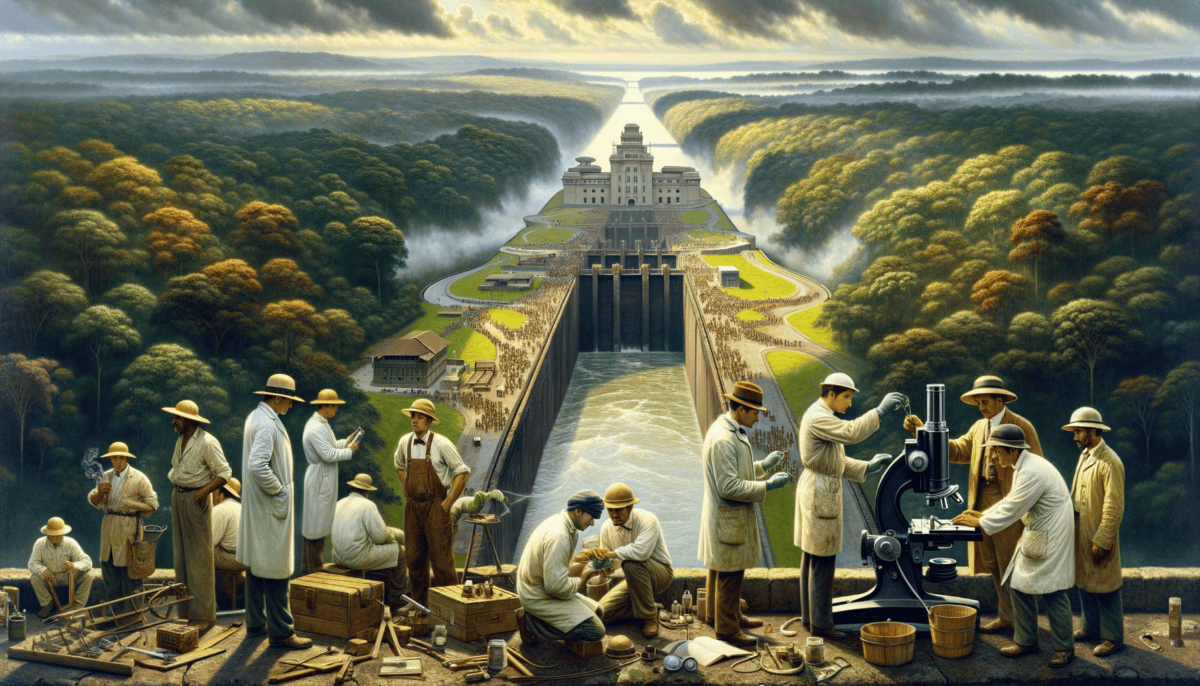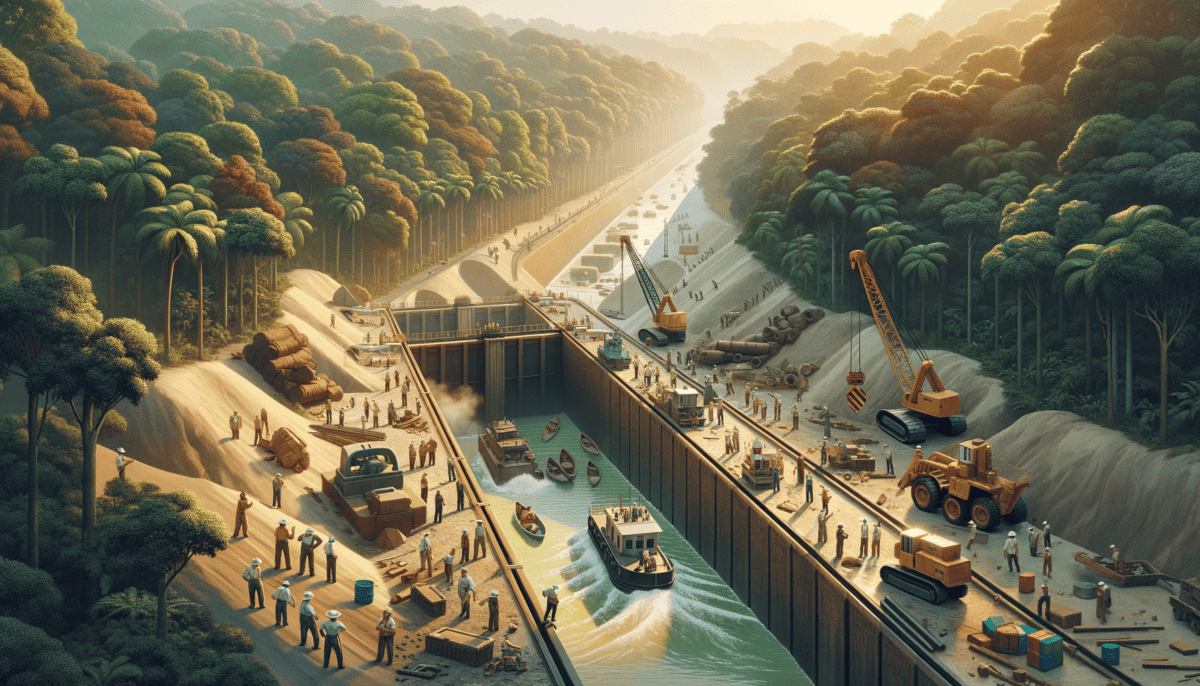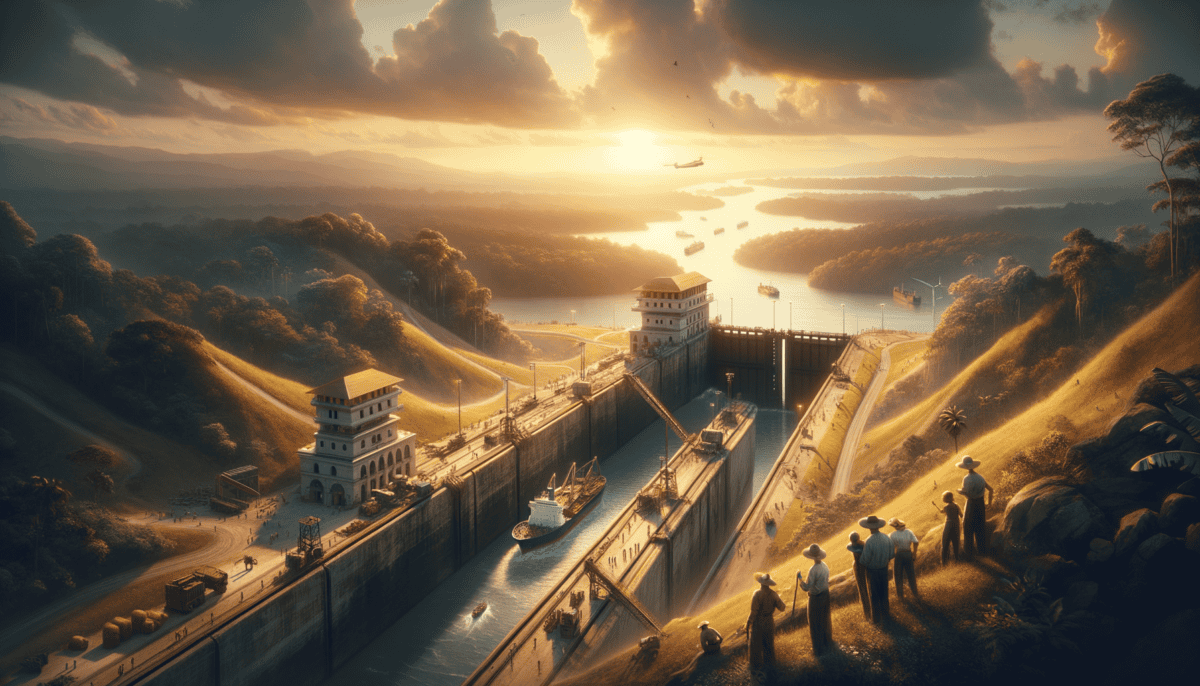A Big Dream Across Two Oceans
The sun blazed hot over Panama in 1904. President Theodore Roosevelt stood tall, looking at maps spread across his desk. His eyes sparkled with excitement as he pointed to a thin strip of land between two mighty oceans. ️
"Here," he said, tapping the map, "we will build something amazing!"
What Roosevelt wanted was bigger than anything anyone had tried before. He dreamed of digging a giant path through Panama that would let ships sail between the Atlantic and Pacific Oceans. Right now, ships had to take a very long trip all the way around South America!
Why We Needed the Canal
Think about how you walk to school. You probably take the shortest path, right? Well, ships needed a shorter path too! Without the canal, ships had to sail an extra 8,000 miles – that's like walking around your school playground 4,000 times!
The First Try That Didn’t Work
Before America tried to build the canal, the French gave it a shot. Their leader was Ferdinand de Lesseps, who had already built a canal in Egypt. But Panama was different!
"This will be easy!" de Lesseps said confidently. But he was wrong.
The French workers faced big problems:
• Hot, sticky weather that made people sick
• Dangerous mudslides
• Thick jungle that was hard to cut through
• Lots of mosquitoes carrying diseases
After eight years of trying, the French had to stop. They had spent lots of money but couldn't finish the job. Many workers got sick, and some even died.
America Takes On the Challenge
Roosevelt wasn't scared by the French failure. He gathered America's best engineers, doctors, and workers. "We can do this," he told them. "We'll learn from what went wrong before."
John Stevens, the chief engineer, looked at the huge mountains they would need to cut through. "It won't be easy," he said, "but we Americans love a challenge!"
The team started making plans. They would need:
- Thousands of workers
- New kinds of machines
- Smart doctors to keep workers healthy
- Clever engineers to solve problems
"We'll need to be creative," Roosevelt said. "This will be the biggest thing America has ever built!"
Colonel William Gorgas, the team's doctor, nodded seriously. "First, we need to make Panama a safer place to work. Those mosquitoes aren't going to stop us!"
Getting Ready for the Big Job
Workers began arriving from all over the world. They came from Jamaica, Barbados, Italy, and many other places. Each person brought special skills and hope for making history.
Little houses started popping up along the canal path. Workers set up camps, and doctors built hospitals. Everyone knew this would be hard work, but they were ready to try.
One worker, James from Jamaica, smiled as he looked at the thick jungle. "My grandfather always said nothing worth doing is easy," he said. "And this? This will be worth doing!"
The sun set over Panama that evening, painting the sky orange and pink. Tomorrow would bring new challenges, but for now, everyone rested, dreaming of the amazing thing they were about to build. The Panama Canal story was just beginning, and what a story it would be!
Fighting Tiny But Mighty Enemies
The workers were ready to dig the big canal, but a tiny enemy was making everyone sick. Mosquitoes! These little bugs were causing big problems in Panama.
The Mystery of the Sick Workers
Dr. William Gorgas walked through the worker camps, worried. More people were getting yellow fever and malaria every day. These sicknesses made people very tired and gave them high fevers.
"We can’t build a canal if everyone is too sick to work," Dr. Gorgas said to his team.
The Smart Doctors Who Solved the Puzzle
Two smart doctors, Dr. Walter Reed and Dr. Carlos Finlay, had made an amazing discovery. They figured out that mosquitoes were spreading the sickness!
"It’s not the air or the water making people sick," Dr. Reed explained. "It’s mosquito bites!"
Dr. Finlay had been saying this for years, but now they could prove it. They did clever experiments with mosquitoes to show how the tiny bugs spread disease.
Fighting Back Against the Bugs
Dr. Gorgas made a plan to fight the mosquitoes. Here’s what they did:
- Sprayed special oil on standing water where mosquitoes laid eggs
- Put screens on windows and doors
- Gave workers mosquito nets for their beds
- Cleaned up puddles and old cans where water collected
- Cut down tall grass where mosquitoes liked to hide
Making Panama Healthier
The fight against mosquitoes wasn’t easy. Some people thought Dr. Gorgas was wasting time and money. But he didn’t give up!
"Every mosquito we stop could save a life," he told his team. "Keep working!"
Slowly, things started getting better. Fewer workers got sick. The hospitals weren’t as full anymore. Dr. Gorgas’s plan was working!
A Big Change for Everyone
The workers noticed the difference too. Maria, a nurse in one of the hospitals, smiled as she looked at the empty beds.
"Last month, we couldn’t find enough space for all the sick people," she said. "Now look – almost everyone is healthy and working!"
John, a canal digger, agreed. "I was scared of getting sick when I first came here," he said. "Now I don’t worry so much. Those doctors really know what they’re doing!"
Lessons for the Future
The fight against mosquitoes in Panama taught doctors important lessons. They learned better ways to keep people healthy in hot, tropical places. These lessons helped people all around the world!
Dr. Gorgas looked at the healthy workers digging the canal. "Now we can focus on building," he said proudly. "We beat the tiny enemies, and the big dream can continue!"
The sun set over Panama, and the workers rested well in their screened houses. Tomorrow would bring new challenges, but at least they didn’t have to worry about mosquitoes anymore!
Moving Mountains and Making History
The workers were healthy and ready for their biggest challenge yet – cutting through a mountain range! ️ This was no ordinary construction job. It would take special machines, clever ideas, and lots of brave workers.
The Big Problem
Chief Engineer John Stevens looked up at the Culebra Cut, a huge mountain in their way. “This mountain has been here for millions of years,” he said. “But we’re going to cut right through it!”
The Magic of Steam Shovels
Giant steam shovels arrived in Panama. These machines were as tall as houses! Each one could lift as much dirt as 50 workers with shovels.
“Watch this!” shouted Mario, a steam shovel operator. He pulled some levers, and the big machine scooped up tons of rock like it was picking up toys.
The workers nicknamed their steam shovels. There was “Old Reliable,” “Big Emma,” and “The Mountain Eater.” These machines worked day and night, taking big bites out of the mountain.
The Smart Lock System
Engineer Emily watched boats trying to climb up hills. “We need a water elevator,” she said. That’s when they came up with the lock system!
Locks work like steps for boats. They fill up with water to lift boats up, then empty to lower them down. It’s like a giant bathtub that moves ships up and down!
Working Together
People came from all over the world to help build the canal. They spoke different languages and had different customs, but they all worked as one team.
Carlos, from Jamaica, worked with Tom from Ireland. “We may talk different,” Carlos said, “but we both know how to move dirt!”
Maria, a cook, made sure everyone stayed strong. “You can’t move mountains on an empty stomach!” she laughed, serving up hot meals.
Dealing with Problems
Sometimes the mountain fought back. Rain made mud slides that filled up their work. The hot sun made the machines too hot. But the workers didn’t give up!
“Every problem has a solution,” Chief Stevens would say. They put up special drains for the rain and worked at night when it was cooler.
Making Progress
Day by day, the mountain got smaller. Train cars carried away the rock and dirt. Workers laid tracks, poured concrete, and built the giant lock gates.
“Look how far we’ve come!” said Tom one evening, pointing at the growing canal. “We’re actually doing it!”
The sun set over Panama, lighting up the changed landscape. Where there was once a mighty mountain, now there was the beginning of a path for ships. The impossible was becoming possible!
Tomorrow would bring more challenges, but the team was ready. They had their steam shovels, their smart ideas, and most importantly, they had each other.
Politics, Partnerships, and Progress
While workers moved mountains in Panama, another kind of challenge was brewing. Leaders from different countries had to work together to make the canal happen.
A New Country Is Born
Panama wanted to be free from Colombia. The United States wanted to build the canal. These two things came together in an exciting way!
“Panama should make its own choices,” said Philippe Bunau-Varilla, a French businessman. He helped Panama become independent in 1903.
Making Friends
John Hay, America’s top diplomat, met with Panama’s leaders. “Let’s work together,” he said. “We can help each other build something amazing!”
They made a special agreement called the Hay-Bunau-Varilla Treaty. The United States would get to build and run the canal, and Panama would get help growing as a new country.
Money Matters
Building a canal wasn’t cheap! Congress had big meetings about spending money. Some people worried it cost too much.
“Think of it as an investment,” said President Roosevelt. “This canal will help ships save time and money forever!”
Congress agreed to spend $375 million. That’s like spending billions of dollars today!
Worker Stories
People from all over came to work on the canal. Each person had their own story:
“I came from Barbados to build a better life,” said Marcus, who operated a drill. “Now I’m helping build something that will change the world!”
Sofia, from Italy, worked in the canal office. “My father was a sailor,” she said. “He would be so proud to see what we’re building.” ♀️
Solving Problems Together
Sometimes the machines broke down. The steam shovels would get stuck in mud, or the drills would hit extra-hard rock.
“We need better tools!” said Chief Engineer Stevens. Engineers invented new ways to drill through rock and move dirt faster. ️
A Growing Community
As more people came to work, towns grew along the canal. They built houses, schools, and stores. Children played while their parents worked on the big project.
“We’re not just building a canal,” said Maria, a teacher. “We’re building a community!”
Looking Forward
Every day brought new challenges, but also new victories. The canal was slowly taking shape, and everyone could feel the excitement growing.
“Soon ships will sail through these hills,” said Tom, watching the sunset. “And we’ll all be able to say we helped make it happen!”
The workers went to bed tired but proud. Tomorrow would bring more work, more challenges, and more chances to make history. The dream of connecting two oceans was getting closer to reality!
Reshaping a Nation
The year was 1908, and the Panama Canal was changing everything! Mountains were moving, valleys were filling, and a dream was coming true. ️
A Day in the Life
The sun wasn’t even up when Jack, a steam shovel operator, started his day. “These mountains won’t move themselves!” he said with a smile. Around him, thousands of workers were already busy.
Nature’s Challenge
The rainforest wasn’t easy to work in. It was hot and sticky, like working in a giant bathtub!
“Sometimes it rains so hard, you can’t see your hand in front of your face,” said Carlos, wiping sweat from his forehead. “But we keep going!”
Big Machines, Big Dreams
Giant steam shovels chomped at the earth like hungry dinosaurs. Trains carried dirt away all day long. The machines had fun nicknames like “Iron Horse” and “Big Dipper.”
Maria, who helped fix the machines, loved her job. “These machines are like big friendly giants,” she said. “They help us do impossible things!”
Living in Canal Town
Workers and their families made homes near the canal. They built parks and started baseball teams. Kids played while watching the huge machines work.
“My daddy helps build the biggest canal in the world!” little Tommy told his friends proudly.
Changing the Land
The canal was like drawing a line through Panama with water! Lakes were made where there used to be hills. Ships would soon sail where people once walked.
“Look how far we’ve come,” said Engineer Stevens, pointing to a map. “We’re not just digging a ditch – we’re making history!” ️
Working Together
People from all over the world worked side by side:
• Jamaica brought strong diggers
• Italy sent skilled stone workers
• Spain provided excellent engineers
• Local Panamanians knew the land best
Nature Fights Back
Sometimes the land didn’t want to change. Mudslides would fill up freshly dug areas. Rain made the ground soft and slippery.
“Nature’s testing us,” said Josh, a digger. “But we’re stronger together!”
Signs of Success
Every day, the canal got bigger. Where there were once hills, water started to flow. The first test boats floated in parts of the canal!
“I can already see ships sailing through,” said Rosa, watching from a hill. “It’s like a dream coming true before our eyes!” ⛴️
Looking to Tomorrow
As the sun set each day, workers could see their progress. The canal was more than just a big dig – it was changing how the whole world would connect.
“Soon,” said Chief Engineer Goethals, “ships from everywhere will pass through here. And we’ll all remember how we made it happen!”
The workers headed home, tired but proud. Tomorrow would bring new challenges, but also new victories. The greatest engineering project in history was almost complete!
A Dream Realized
The big day finally arrived! On August 15, 1914, the SS Ancon became the first ship to officially sail through the completed Panama Canal.
The Grand Opening
Thousands of people gathered to watch history happen. Flags waved in the breeze, and music filled the air. Little Tommy, now a bit taller, stood with his dad.
“We did it, son,” his father said proudly. “We built something that will last forever.”
How It Works
The canal worked like a giant water elevator! Ships would enter special pools called locks. Water would fill up or drain out, lifting or lowering the ships. ️
Maria watched as the first ship rose up in the locks. “It’s like magic,” she whispered, “but it’s really just smart engineering!”
A World Changed Forever
Ships no longer had to sail all the way around South America. The journey that once took months now only took about 8-10 hours! Here’s what changed:
• Ships saved thousands of miles of travel
• Goods moved faster between countries
• More trade made everything cheaper
• People could visit new places easier
• Different cultures came closer together
The Workers Celebrate
Jack, the steam shovel operator, couldn’t stop smiling. “Remember when this was all just dirt and trees?” he asked his friends. “Now look at it!”
Carlos, still wiping his brow out of habit, nodded. “And we were here to build it!”
Stories to Tell
Rosa started writing down everything she remembered. “Our grandchildren need to know what happened here,” she said. “We moved mountains and filled valleys. We fought disease and won. We did what everyone said was impossible!”
The Canal Today
The Panama Canal keeps getting better! In 2016, it got bigger to fit even larger ships. Every year, about 14,000 ships pass through. In fact, right now, a ship might be going through the canal!
A Lasting Legacy
The Panama Canal shows what people can do when they work together. It wasn’t just about digging a big ditch – it was about dreaming big and never giving up.
“Look at what we built,” Engineer Goethals said at the opening ceremony. “When people say something’s as big as the Panama Canal, they’ll mean it’s really important!”
The Future Ahead
Today, the Panama Canal connects our world more than ever. Ships carry toys, food, cars, and everything else through it every day.
And it all started with a dream – a dream that said we could cut a path through mountains, fill it with water, and sail ships through a jungle. A dream that came true because people dared to think big and work hard.
Every time a ship passes through the Panama Canal, it carries with it the story of the brave, smart, and determined people who built this amazing gateway between two oceans. And that story will sail on forever! ⚓






